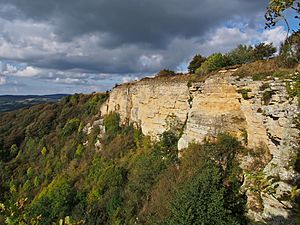Hambleton Hills facts for kids

The Hambleton Hills are a beautiful range of hills located in North Yorkshire, England. They form the western edge of the North York Moors National Park. A valley carved by the River Rye separates them from the main moors. To their west, they meet the flat Vale of Mowbray with a steep, dramatic slope.
These hills stretch for about 15 miles (24 km) from north to south. In the north, they connect with the Cleveland Hills, and in the south, they join the Howardian Hills.
The Hambleton Hills are made of rocks from the middle and late Jurassic period, which was a very long time ago! The hardest rock, called Corallian Limestone, forms the tops of the highest points. The tallest spot is Black Hambleton, which reaches 1,308 feet (400 meters) high at the northern end of the range. Other notable points include Roulston Scar, at 919 feet (280 meters), and Whitestone Cliff, at 1,063 feet (324 meters). This same Corallian Limestone also forms the Tabular Hills to the east, which stretch all the way to Scarborough.
Long ago, in the 12th and 13th centuries, the Hambleton Hills were known for making a special kind of pottery called York Glazed Ware. This was a popular type of Medieval ceramic.
Contents
Cool Places to Explore
Sutton Bank's Amazing Views
Sutton Bank is a high point on the Hambleton Hills, also known as Roulston Scar. From here, you can see incredible, wide-open views across the Vale of York and the Vale of Mowbray. It's a fantastic spot for taking photos! This hill is also home to an important ancient site: an Iron Age hill fort built around 400 BC. Imagine people living and defending themselves here so long ago!
The Ancient Hambleton Drove Road
An old path called the Hambleton Drove Road runs along the top of these hills. It's part of a very old highway that once stretched from Scotland all the way to the south of England. Experts believe it's even older than recorded history! Along its route, you can find ancient burial grounds from the Neolithic and Bronze Ages. In the 18th and 19th centuries, this road became famous for moving large groups of cattle from Scotland to markets in England, which is how it got its name.
The Battle of Old Byland
In 1322, an important historical event happened here. The Pass of Byland was taken over by an invading Scottish army led by Sir James Douglas. This led to the Battle of Old Byland, where the English king Edward II's army was defeated.
The Kilburn White Horse
In 1857, something truly unique was created on the hills. A giant white horse figure was carved into the limestone above the village of Kilburn. It was made by the village schoolmaster, John Hodgson, and is a famous landmark you can still see today!
Local Area and Government
Most of the Hambleton Hills are located within the Ryedale District. The steep western side of the hills is part of the Hambleton District, which was actually named after these very hills! The entire range of hills is also part of the beautiful North York Moors National Park, which helps protect its natural beauty.
The Hambleton Royal Gold Cup
Did you know that horse racing used to take place right here on Black Hambleton? From at least the time of Queen Anne, a famous horse race called the Hambleton Royal Gold Cup was held.
This race was open to horses aged 5 years or younger and covered a distance of 4 miles (6.4 km). Each horse had to carry 10 stone (63.5 kg). The very first race was won by a stallion named Syphax, owned by Sir William Strickland. The race was usually held on the Saturday before the August York race meeting.
The Hambleton Royal Gold Cup continued to be run at Black Hambleton until 1776. After that, it was held sometimes at Black Hambleton and sometimes at the Knavesmire in York. Eventually, by the mid-1800s, the race was only held at York Racecourse. However, horse training continued at stables in Hambleton House and the nearby small village of Hambleton.


